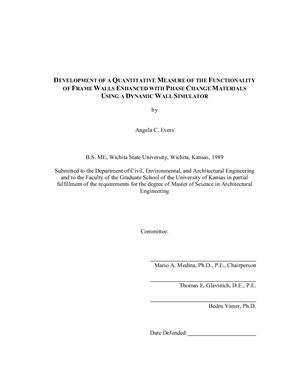На английском языке. Магистерская диссертация. Работа выполнена в
University of Kansas, 2008, 99pp.
ABSTRACT
The incorporation of phase change materials (PCMs) in building components
for use as latent heat storage and for potential reduction of energy requirements is an
on-going field of study. In this thesis, the development and testing of PCM-enhanced
cellulose insulation for use in frame walls is presented. Three types of PCMs
(paraffin-based, hydrated salt-based, and eutectic) were mixed with loose-fill
cellulose insulation at various concentrations in a 1.19 m x 1.19 m (47 in. x 47 in.)
frame wall cavity. The thermally-enhanced frame walls were heated and allowed to
cool in a dynamic wall simulator that replicated the sun’s exposure in a wall on a
typical summer day. Heat fluxes, total heat flows, and surface and air temperatures
were measured. Results from simulation testing showed that the paraffin-based PCM,
RT27®, reduced the average peak heat flux by up to 9.2% and reduced the average
total daily heat flow up to 1.2%. A powdered paraffin PCM, PX27®, reduced the
average peak heat flux up to 9.3%, but did not decrease the total daily heat flow.
Because of the hydroscopic nature of hydrated salts, the hydrated salt-based PCM and
the eutectic salt/paraffin PCM did not provide any thermal storage benefit.
Estimations of the equivalent thermal resistance for the paraffin-based PCM, RT27®,
showed an increase of up to 60% when compared to the control wall.
ABSTRACT
The incorporation of phase change materials (PCMs) in building components
for use as latent heat storage and for potential reduction of energy requirements is an
on-going field of study. In this thesis, the development and testing of PCM-enhanced
cellulose insulation for use in frame walls is presented. Three types of PCMs
(paraffin-based, hydrated salt-based, and eutectic) were mixed with loose-fill
cellulose insulation at various concentrations in a 1.19 m x 1.19 m (47 in. x 47 in.)
frame wall cavity. The thermally-enhanced frame walls were heated and allowed to
cool in a dynamic wall simulator that replicated the sun’s exposure in a wall on a
typical summer day. Heat fluxes, total heat flows, and surface and air temperatures
were measured. Results from simulation testing showed that the paraffin-based PCM,
RT27®, reduced the average peak heat flux by up to 9.2% and reduced the average
total daily heat flow up to 1.2%. A powdered paraffin PCM, PX27®, reduced the
average peak heat flux up to 9.3%, but did not decrease the total daily heat flow.
Because of the hydroscopic nature of hydrated salts, the hydrated salt-based PCM and
the eutectic salt/paraffin PCM did not provide any thermal storage benefit.
Estimations of the equivalent thermal resistance for the paraffin-based PCM, RT27®,
showed an increase of up to 60% when compared to the control wall.

